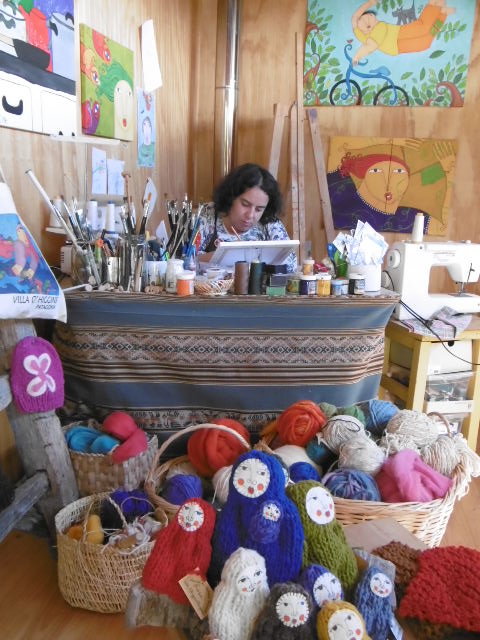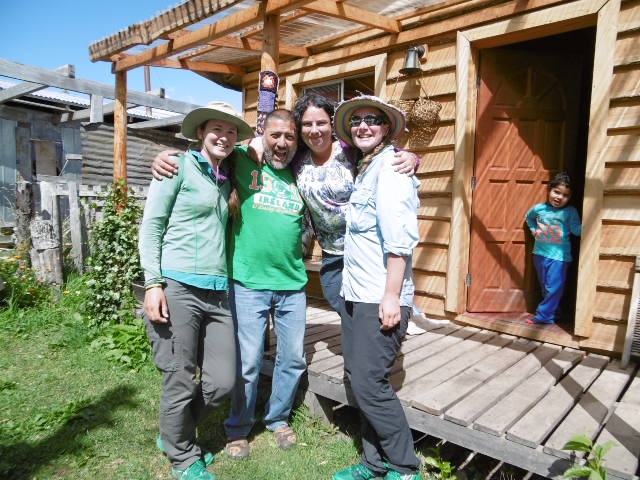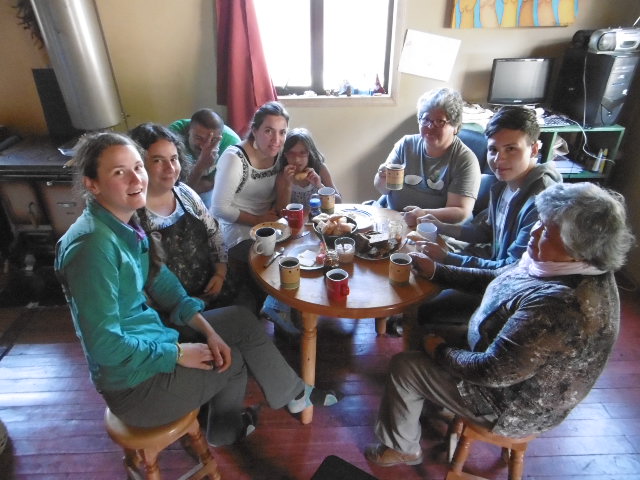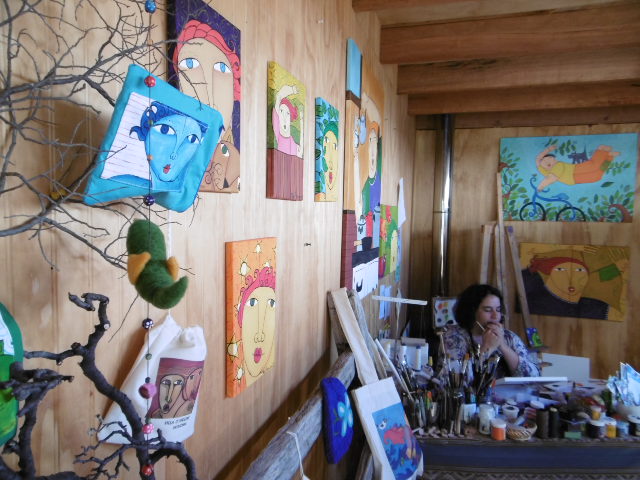Haz clic aquí para leer en español
 Marcela Stormesan sits nestled in the corner of her small studio, El Bosque.
Marcela Stormesan sits nestled in the corner of her small studio, El Bosque.
Whimsical figures cook, float, swim, knit or simply watch from canvases hung on wooden walls. They dance upon scenes of wind and leaves, gaze at stars and waves.
Pajaritos are woven in, some occupying their own canvases, their seeing eyes peer thoughtfully.
“The pajaritos were inspired by my friend. In her later years, she realized she could continue being comfortable in the life she had, or she could seek to be truly happy.” She divorced and left her home, “what courage she had, to give up everything she knew,” Marcela reflects, “now she says it is her mission to spread love. She says that we each have a pajarito en la cabeza [a little bird in/on our head]. This is why I paint them in to many of my pieces.”
“My family moved to Coyhaique in 1977. I grew up without a TV. Back then, the winters were much more crudo, so we entertained ourselves with our hands. When I was 15, I saw a tapiza a friend had made; that was my inspiration to begin painting. I like having my own shop, because I can do whatever I feel like on each day.”
The walls not only of her shop, but also of the entire town, are a testament to this. Any person who visits this town must swing through her studio. As we sat there, drinking cappuccinos made from their fancy new machine, two officials from the municipality stopped by to discuss permits. They each walk out with one of her pieces tucked under their arms.
 In any given establishment in town, there are paintings, mobiles, bags, calendars, conservation posters, poetry books, hats, dolls – all of her making. “I imagine the pioneer women making dolls for their children. They did not have much, so I imagine they made their children’s toys,” she smiles at the coven of handmade dolls which sit in the middle of her shop. Each doll’s face is distinct and hand painted, their bodies home-stitched. Each is assigned a name of one of the original pioneer women of the town.
In any given establishment in town, there are paintings, mobiles, bags, calendars, conservation posters, poetry books, hats, dolls – all of her making. “I imagine the pioneer women making dolls for their children. They did not have much, so I imagine they made their children’s toys,” she smiles at the coven of handmade dolls which sit in the middle of her shop. Each doll’s face is distinct and hand painted, their bodies home-stitched. Each is assigned a name of one of the original pioneer women of the town.
“I was not well in Coyhaique; I was depressed,” her countenance darkens and she pauses. “I had a big house full of a lot of things. I worked all day to pay for these things around me and instead of making me feel better, they were a tether. Eight years ago, I decided I would never again pay rent. Three friends who live in Villa O’Higgins invited me to come down here. They said all I needed to do was paint. They protected me. Jorge owned El Mosco then, and he let me stay in one of the rooms there. As I painted more, I began to feel more complete.”
 Within a month, at the age of 35, she met Rodrigo. “When I met him I realized I had been painting him for 20 years. It was as if he had stepped out of my paintings.” ,”El Profe,” the townspeople call him. The man is heartfelt and witty. He sits and chats and teases. Wearing many hats: music teacher, re-purposed material mural artist, director of the local radio, glacier protector, and full time father to their spirited son, Leon.
Within a month, at the age of 35, she met Rodrigo. “When I met him I realized I had been painting him for 20 years. It was as if he had stepped out of my paintings.” ,”El Profe,” the townspeople call him. The man is heartfelt and witty. He sits and chats and teases. Wearing many hats: music teacher, re-purposed material mural artist, director of the local radio, glacier protector, and full time father to their spirited son, Leon.
“Rodrigo makes beds and cleans the bathroom. One time, one of my aunts came to visit, and she saw him cleaning house, she was horrified. Later she told me that I need to take better care of my man, or he will get bored and leave me. She said that I needed to bear him another son, or he will go looking elsewhere. I told her he’d have to, because I’m not having any more children!” Marcela throws her head back. Her laugh bubbles from the soul and chortles in her throat.
 Their life is more simple now but ever full. The door is never locked and frequently shadowed by all number of people. She and Rodrigo dream of one day growing the business into a coffee shop by day and lounge in the evening. “If people can sit and drink a coffee, they can be with the art and it has a chance to speak to them.”
Their life is more simple now but ever full. The door is never locked and frequently shadowed by all number of people. She and Rodrigo dream of one day growing the business into a coffee shop by day and lounge in the evening. “If people can sit and drink a coffee, they can be with the art and it has a chance to speak to them.”
They are clearly people who love having others around, so it would be more an extension of their living room (where I currently sit).
“Then in the evenings, we can have music,” Rodrigo adds, “I can play my saxophone.”
Marcela’s open heart and hospitality are a manifestation of the inspiration in the forest of this area. “This is why I am right here. When at first we looked at this spot, people said that no, this gets the least sun in the winter. I chose it anyway, because it looks out on the park, so I will never be surrounded by houses. I am surrounded by forest. I love the forest. La naturaleza te aturbe,”she looks out the window of their home at the lush trees.
Rodrigo rounds out the thought, “it is a constant invitation to be inspired.”

Su Historia: Ella puede pintar
Traducción por Henry Tovar
 Marcela Stormesan se sienta en una esquina de su pequeño estudio, El Bosque.
Marcela Stormesan se sienta en una esquina de su pequeño estudio, El Bosque.
Caprichosas figuras cocinan, flotan, nadan, tejen o simplemente ven desde lienzos colgados en las paredes de madera. Bailan en escenas de viento y hojas, miran a las estrellas y a las olas.
Pajaritos se tejen, algunos ocupando sus propios lienzos, sus ojos se asoman cuidadosamente.
´´Los pajaritos fueron inspirados en mi amiga. En sus ultimos años, se dió cuenta de que podía seguir sintiendose cómoda con la vida que tenía, o podría tratar de ser realmente feliz´´.
ella se divorció y se fue de su casa, ´´que valor que tenía a renunciar a todo lo que conocía´´, Marcela refleja, ´´ahora dice que su misión es la de difundir el amor´´.´´ Ella dice que cada uno tiene un pajarito en la cabeza. Es por eso que les pinto en muchas de mis piezas´´.
´´Mi familia se trasladó a Coyhaique en 1977. Crecí sin un televisor. En aquel entonces, los inviernos eran muchos más crudos, por lo que nos entreteníamos a nosotros mismos con nuestras manos. Cuando tenía 15 año, vi una tapiza que un amigo había hecho; que fue mi inspiración para comenzar a pintar. Me gusta tener mi propia tienda, porque puedo hacer lo que sea que siento cada día´´.
Las paredes no sólo de su tienda, sino también de toda la ciudad, son una prueba de ello. Cualquier persona que visita esta ciudad debe pasarse por su estudio. Al sentarnos allí, bebiendo capuchinos hechos de una nueva máquina de lujo, dos funcionarios de la municipalidad se detuvieron para hablar sobre persmisos. Cada uno de ellos salen con una de sus piezas bajo el brazo.
 En cualquier establecimiento de la ciudad, hay pinturas, móviles, bolsos, calendarios, carteles, libros de poesía de conservación, sombreros, muñecas – todo hecho por ella.
En cualquier establecimiento de la ciudad, hay pinturas, móviles, bolsos, calendarios, carteles, libros de poesía de conservación, sombreros, muñecas – todo hecho por ella.
´´Me imagino a las mujeres pioneras haciendo muñecos para sus hijos. Ellas no tenían mucho, así que imagino que ellas hacían los juegetes para sus hijos´´, ella sonríe hacía la asamblea de brujas de juguete hechas a mano que estan en el medio de su estudio. La cara de cada muñeca
es distinta y pintada a mano, sus cuerpos cosidos en casa.
Cada uno se le asigna un nombre de una de las mujeres pioneras originarias del pueblo.
´´No estaba bien en Coyhaique; Yo estaba deprimida, ´´su rostro se oscurece y hace una pausa. ´´Tenía una gran casa llena de un montón de cosas. Trabajaba todo el día para pagar por esas cosas a mi alrededor y en vez de hacerme sentir mejor, era una correa que me sujetaba. Hace ocho años, decidí que no volvería a pagar el alquiler. Tres amigos que viven Villa O´higgins me invitaron a venir aquí.
Dijeron que todo lo que tenía que hacer era pintar. Ellos me protegían. Jorge era el propietario de El Mosco entonces, y él me dejó estar en una de las habitaciones allí. Mientrás más pintaba, más completa me sentía´´.
 Lluego de un mes, a la edad de 35, conocio a Rodrigo. ´´cuando lo conocí me di cuenta de que lo había estado pintando durante 20 años. Era como si hubiera salido de mis pinturas´´, ´´El Profe´´, la gente del pueblo le llaman. El hombre es sincero e ingenioso. Se sienta y conversa y se burla. Haciendo varios papeles: profesor de música, artista de mural con materiales reciclados, director de la radio local, protector glaciar y padre a tiempo completo a su hijo de espiritú, Leon.
Lluego de un mes, a la edad de 35, conocio a Rodrigo. ´´cuando lo conocí me di cuenta de que lo había estado pintando durante 20 años. Era como si hubiera salido de mis pinturas´´, ´´El Profe´´, la gente del pueblo le llaman. El hombre es sincero e ingenioso. Se sienta y conversa y se burla. Haciendo varios papeles: profesor de música, artista de mural con materiales reciclados, director de la radio local, protector glaciar y padre a tiempo completo a su hijo de espiritú, Leon.
´´Rodrigo hace camas y limpia el baño. En una ocasión, una de mis tías vino a visitarme, y lo vio limpieza de la casa, se horrorizó. Más tarde me dijo que tenía que cuidar mejor de mi hombre, o el se aburriría y me dejaría. Ella dijo que tenía que darle otro hijo, o él lo iría a buscar a otra parte.
Yo le dijé que él tendría que hacerlo entonces, porque yo no voy a tener más hijos!. ´´Marcela echa la cabeza hacia átras. Su risa burbujeaba desde el alma y se asomaba por su garganta.
 Su vida es mas sencilla ahora, pero siempre llena. La puerta nunca está cerrada y con frecuencia ensombresida por todo un número de persona. Ella y Rodrigo sueñan de algún día hacer crecer el negocio en una cafetería durante el día y salón por la noche. ´´si la gente puede sentarse
Su vida es mas sencilla ahora, pero siempre llena. La puerta nunca está cerrada y con frecuencia ensombresida por todo un número de persona. Ella y Rodrigo sueñan de algún día hacer crecer el negocio en una cafetería durante el día y salón por la noche. ´´si la gente puede sentarse
a tomar cun café, pueden hacerlo con el arte y existe la oportunidad de hablar con ellos´´. Es evidente que son personas que les gusta tener a otros alrededor, por lo que sería más una extensión de su sala de estar (donde me siento actualmente) ´´luego de la cena, podemos tener la música´´, añade Rodrigo,
´´Puedo tocar mi saxofón´´. El corazón abierto y la hospitalidad de Marcela son una manifestación de la inspiración en el bosque de esta zona. ´´Esto es por qué estoy aquí. Cuando al principio nos fijamos en este lugar, la gente decía que no, esto se pone el sol por lo menos en el invierno. Lo elegimos de todos modos, ya que mira hacía el parque, por lo que nunca estará rodeado de casas. Estoy rodeada de bosques. Me encanta el bosque. La naturaleza te aturbe. ´´ ella ve por la ventana de su casa a los árboles frondosos. Rodrigo completa el pensamiento, ´´es una invitación constante para ser inspirado´´.







Comments (1)
Pingback: Herstory: Ella Puede Coser/ She can Sew – Her Odyssey